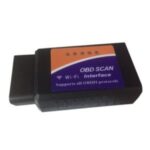The Acura Integra, a legend in the sport compact world, demands precision when it comes to maintenance and performance tuning. An Integra Obd2 Scanner is an essential tool for any owner looking to diagnose issues, monitor engine performance, and unlock the full potential of their vehicle. This comprehensive guide will delve into the intricacies of using an OBD2 scanner on your Integra, covering various models and engine configurations.
Understanding Your Integra’s OBD2 System
Before diving into scanner specifics, it’s crucial to understand the basics of OBD2 (On-Board Diagnostics II). This standardized system allows you to access your Integra’s engine control unit (ECU) and retrieve valuable diagnostic information.
OBD2 Protocols and Your Integra
Different Integra generations utilize different OBD2 protocols:
- 1996-1999 Integra (OBD2a): These models use the OBD2a protocol.
- 2000-2001 Integra (OBD2b): These later models transitioned to the OBD2b protocol, featuring minor differences in communication and connector pinouts.
Understanding this distinction is critical when choosing a compatible integra obd2 scanner.
Choosing the Right Integra OBD2 Scanner
The market offers a wide array of OBD2 scanners, ranging from basic code readers to advanced professional-grade tools. For your Integra, consider these factors:
Basic Code Readers:
- Functionality: These entry-level scanners retrieve and clear diagnostic trouble codes (DTCs). Ideal for identifying simple issues like misfires or sensor malfunctions.
- Compatibility: Ensure compatibility with your Integra’s specific OBD2 protocol (OBD2a or OBD2b).
- Cost: Generally the most affordable option.
Advanced Scan Tools:
- Functionality: Offer extensive data logging, live sensor readings, and advanced diagnostics beyond basic code reading. Crucial for performance tuning and in-depth troubleshooting.
- Features: Look for features like ABS and SRS system diagnostics, bi-directional controls (for activating components), and data graphing capabilities.
- Compatibility: Professional-grade scanners often support both OBD2a and OBD2b protocols, ensuring compatibility across all Integra generations.
- Cost: Significantly more expensive than basic code readers, but offer unparalleled diagnostic power.
OBD2a vs. OBD2b Wiring Harness Comparison
Using an OBD2 Scanner on Your Integra
Connecting and using an OBD2 scanner on your Integra is straightforward:
- Locate the OBD2 Port: Typically located under the dashboard on the driver’s side.
- Connect the Scanner: Plug the scanner into the OBD2 port.
- Turn the Ignition On: Turn the key to the “on” position (do not start the engine).
- Read Codes/Data: Follow the scanner’s instructions to retrieve and interpret DTCs or access live data streams.
Wiring Diagram for 96-98 Civic (Applicable to similar Integra models)
Wiring Diagram for 99-00 Civic (Applicable to similar Integra models)
Beyond Basic Code Reading: Advanced Diagnostics
With an advanced integra obd2 scanner, you can delve deeper into your car’s systems:
- Live Data: Monitor real-time sensor readings like engine coolant temperature, intake air temperature, and oxygen sensor voltage. Crucial for identifying performance issues.
- Data Logging: Record sensor data over time to analyze trends and pinpoint intermittent problems.
- Freeze Frame Data: Capture a snapshot of sensor readings at the moment a DTC was triggered, providing valuable context for diagnosis.
OBD2 to OBD1 Injector Clip Modification
OBD1 vs. OBD2 Alternator Plug Comparison
Conclusion: Empowering Integra Owners
An integra obd2 scanner is a powerful tool for understanding and maintaining your Acura Integra. Whether you’re a seasoned enthusiast or a new owner, choosing the right scanner and understanding its capabilities will empower you to diagnose issues, optimize performance, and keep your Integra running smoothly for years to come.

